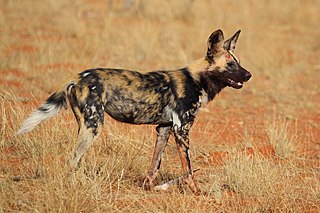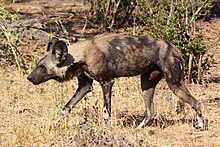
Jackals are medium-sized omnivorous mammals of the subtribe Canina, which also includes wolves and the domestic dog, among other species. While the word "jackal" has historically been used for many small canines, in modern use it most commonly refers to three species: the closely related black-backed jackal and side-striped jackal of sub-Saharan-Africa, and the golden jackal of south-central Europe and Asia.

The serval is a wild cat native to Africa. It is rare in North Africa and the Sahel, but widespread in sub-Saharan countries except rainforest regions. Across its range, it occurs in protected areas, and hunting it is either prohibited or regulated in range countries.

Gonarezhou National Park is a national park located in south-eastern Zimbabwe. It is situated in a relatively remote corner of Masvingo Province, south of Chimanimani along the Mozambique border. Owing to its vast size, rugged terrain and its location away from main tourist routes, large tracts of Gonarezhou remain as pristine wilderness.

The southern reedbuck, rietbok or common reedbuck is a diurnal antelope typically found in southern Africa. It was first described by Pieter Boddaert, a Dutch physician and naturalist, in 1785. It is placed in the genus Redunca and family Bovidae. This antelope has an average mass of 58 kg (128 lb) and a body length of about 134–167 cm (53–66 in).

Sharpe's or northern grysbok is a small, shy, solitary antelope that is found from tropical to south-eastern Africa.

The wildlife of South Africa consists of the flora and fauna of this country in southern Africa. The country has a range of different habitat types and an ecologically rich and diverse wildlife, vascular plants being particularly abundant, many of them endemic to the country. There are few forested areas, much savanna grassland, semi-arid Karoo vegetation and the fynbos of the Cape Floristic Region. Famed for its national parks and big game, 297 species of mammal have been recorded in South Africa, as well as 858 species of bird and over 20,000 species of vascular plants.

The Natal red rock hare or greater red rock hare is a species of mammal in the family Leporidae. It has a slightly grizzled, grayish brown head and reddish brown upperparts. The dense fur is thick and rougher than other rock hares. It is endemic to Africa, and found in southeastern provinces of South Africa, eastern Lesotho, Swaziland, and southern Mozambique. It is a herbivore, primarily feeding on grass. It breeds throughout the year, and one or two pups are usually born in the summer. It is rated as a species of least concern on the IUCN Red List of Endangered Species.

Smith's red rock hare is a species of mammal in the family Leporidae, and is the smallest member of the genus Pronolagus. The upperparts and gular collar are reddish brown in colour. It has warm, brown, grizzled, thicker hairs at the back of the body, and white to tawny, thinner underfur. It is endemic to Africa, found in parts of Kenya, Lesotho, Malawi, Namibia, Rhodesia, South Africa, Tanzania and Zambia. It is a folivore, and usually forages on grasses, shrubs and herbs. It breeds from September to February, and the female litters one or two offspring. Being a leporid, the hare's offspring is called a leveret, or leverets (plural). The young leave the nest at three years of age. In 1996, it was rated as a species of least concern on the IUCN Red List of Endangered Species.

The African wild dog is a canine which is a native species to sub-Saharan Africa. It is the largest wild canine in Africa, and the only extant member of the genus Lycaon, which is distinguished from Canis by dentition highly specialised for a hypercarnivorous diet, and a lack of dewclaws. It is estimated that about 6,600 adults including 1,400 mature individuals live in 39 subpopulations that are all threatened by habitat fragmentation, human persecution and outbreaks of diseases. As the largest subpopulation probably consists of less than 250 individuals, the African wild dog is listed as endangered on the IUCN Red List since 1990.

The South African giraffe or Cape giraffe is a subspecies of giraffe ranging from South Africa, Namibia, Botswana, Zimbabwe, Mozambique. It has rounded or blotched spots, some with star-like extensions on a light tan background, running down to the hooves.

The Somali wild dog is a subspecies of African wild dog native to the Horn of Africa. It is similar to the East African subspecies, but is smaller, has shorter and coarser fur and has a weaker dentition. Its colour closely approaches that of the Cape subspecies, with the yellow parts being buff, rather than bright orange, as is the case in the East African subspecies.

The East African wild dog is a subspecies of African wild dog native to East Africa. It is distinguished from the nominate Cape subspecies by its smaller size and much blacker coat.

The Southeast African cheetah is the nominate cheetah subspecies native to East and Southern Africa. The Southern African cheetah lives mainly in the lowland areas and deserts of the Kalahari, the savannahs of Okavango Delta, and the grasslands of the Transvaal region in South Africa. In Namibia, cheetahs are mostly found in farmlands.
The Chad wild dog, also known as the Shari River hunting dog, the Saharan wild dog or the Central African wild dog, is a subspecies of the African wild dog native to Central Africa.

The West African wild dog is a subspecies of the African wild dog native to West Africa. It is classified as Critically Endangered by IUCN, as it was estimated that 70 adult individuals are left in the wild.
A hunting dog is a canine that hunts with or for humans.


















